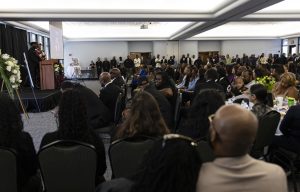Micro monitors displayed in Biomedical lecture
September 23, 2009
Heart monitors that used to weigh thousands of pounds and required several people to administer them are now no bigger than a deck of cards and can be work on the body of a patient. This advancement in biomedical engineering is in part thanks to a highly esteemed professor in the Department of Electrical and Electronic Engineering at Sacramento State.
Dr. Warren D. Smith, who has been a part of the engineering program at Sacramento State since 1973, gave a lecture on his work with wearable heart monitors Tuesday in the University Union Redwood Room.
Smith’s lecture, called “Biomedical Engineering- Micro monitoring your health” was the first Science, Technology, Engineering and Mathematics (STEM) lecture this year.
Smith is known as a leader in the biomedical engineering program at Sac State and in the region. He has taught and developed 13 courses in biomedical engineering for undergraduate and graduate students, served as thesis chair and co-chair for graduate thesis work of medical engineering students and his work appears in more than 100 peer reviewed publications.
“He has combined work in microelectronics, chip design, wireless sensors. All of it on behalf of developing these instruments that will help us better monitoring our bodies, to be able to better understand our prognosis, and hopefully for all of us to stay healthy,” said Emir Macari, Sac State dean of engineering and computer science.
There are three main uses of Smith’s miniature electroencephalograms (EEGs). They monitor depth of anesthesia, monitor the physical and mental workloads of medical workers and monitor the activities and falls of children with cerebral palsy.
Smith has worked with Shriner’s Hospital for Children to develop and implement the wearable monitors.
Currently, Smith’s work consists of developing miniature wearable monitors to be worn by cerebral palsy patients at Shriner’s to log a child’s activity level and number of falls during everyday living before and after various treatments to measure the effectiveness of the treatment.
“We monitored 86 children this way and collected several hundred hours of data of children playing,” Smith said.
To get a real feel of what these monitors are capable of doing Smith asked people from the audience to test the heart monitors while the results streamed simultaneously on the projected screen.
“This is just the beginning. This is going so many places,” said Suvarna Dabke, a recent graduate of the Electrical and Electronics Engineering program, present at the lecture. “A lot of students don’t even know that being an engineering student you can also help humankind. Being an electronics engineer isn’t just building robots and computers.”
Helping people is, in fact, what interested Smith to pursue biomedical engineering.
“I became a biomedical engineer because I wanted to apply my engineering know-how to help people with medical needs,” Smith said in his closing remarks. “I am delighted when students come to me with the same desire.”
























































































































